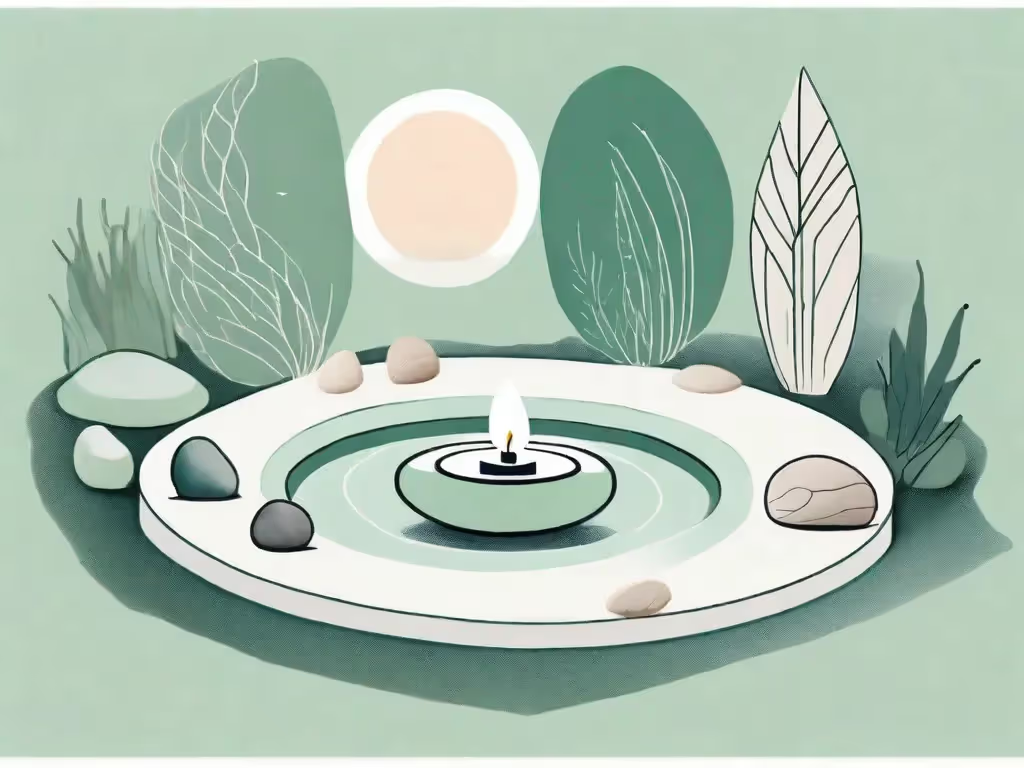Meditation has long been recognized for its numerous benefits in promoting overall well-being. One particular form of meditation that has gained popularity in recent years is Kujiin Meditation. This ancient practice combines hand mudras, mantras, and breathing techniques to cultivate physical, mental, and spiritual growth. In this article, we will delve into the techniques and benefits of Kujiin Meditation, debunk common misconceptions, and provide tips on how to incorporate this practice into your daily routine.
Understanding Kujiin Meditation
Kujiin Meditation originated in Japan and is deeply rooted in Eastern philosophy and spirituality. Its origins can be traced back to the esoteric practices of Buddhist and Shinto traditions. The philosophy behind Kujiin is to harmonize the mind, body, and spirit through a series of hand mudras, which are specific hand gestures, combined with mantras and focused breathing.
The Origins of Kujiin Meditation
The history of Kujiin Meditation can be dated back to the ancient samurai warriors who sought to enhance their focus and clarity in battle. These warriors recognized the importance of not only physical strength but also mental and spiritual fortitude. They understood that to be successful in combat, one needed to have a calm and focused mind.
Over time, the practice of Kujiin Meditation evolved beyond the battlefield and became a spiritual practice that aimed to connect with the divine energy present in all living beings. It was believed that by mastering the art of Kujiin Meditation, one could tap into the universal life force and attain enlightenment.
The Philosophy Behind Kujiin Meditation
Kujiin Meditation is based on the belief that each hand mudra corresponds to a different elemental energy within the body. These elemental energies are associated with specific qualities and characteristics. By combining these mudras with mantras, practitioners aim to activate and balance these energies, thus promoting physical and spiritual well-being.
For example, the mudra for fire is believed to ignite passion and determination, while the mudra for water is associated with emotional balance and adaptability. By performing these hand gestures in conjunction with the corresponding mantras, practitioners seek to harness the power of these elemental energies and bring about positive changes in their lives.
In addition to the hand mudras and mantras, focused breathing plays a crucial role in Kujiin Meditation. By controlling the breath, practitioners are able to regulate their energy flow and achieve a state of deep relaxation and heightened awareness. This allows them to delve into their inner selves and explore the depths of their consciousness.
Furthermore, Kujiin Meditation is not limited to physical practice alone. It encompasses a holistic approach to life, encouraging practitioners to cultivate virtues such as compassion, gratitude, and mindfulness. It is believed that by embodying these qualities, individuals can lead more fulfilling and purposeful lives.
In conclusion, Kujiin Meditation is a profound spiritual practice that combines hand mudras, mantras, and focused breathing to harmonize the mind, body, and spirit. Its origins can be traced back to ancient samurai warriors, but it has since evolved into a practice that is accessible to anyone seeking inner peace and self-discovery. Through the activation and balance of elemental energies, practitioners of Kujiin Meditation strive to unlock their full potential and connect with the universal life force.
The Techniques of Kujiin Meditation
The practice of Kujiin Meditation involves several key techniques that work synergistically to promote a deep and transformative meditative experience. These techniques include hand mudras, mantras, breathing exercises, and visualization.
The Role of Hand Mudras in Kujiin
Hand mudras are specific hand positions that help channel and direct energy within the body. Each mudra corresponds to a different aspect of consciousness and has its own unique purpose. By adopting these mudras during meditation, practitioners aim to harmonize and align the mind, body, and spirit.
For example, the "Gyan Mudra" involves touching the tip of the thumb to the tip of the index finger, while extending the other three fingers. This mudra is believed to enhance wisdom, knowledge, and concentration. Similarly, the "Anjali Mudra" involves pressing the palms together in front of the heart, symbolizing gratitude and reverence.
As practitioners hold these hand mudras during meditation, they can experience a heightened sense of connection to their intentions and the energy flowing through their bodies. The mudras serve as physical anchors, grounding the mind and allowing for a deeper exploration of consciousness.
The Importance of Mantras in Kujiin
Mantras are sacred words or phrases that are repeated during meditation to focus the mind and invoke specific intentions or energies. In Kujiin Meditation, the recitation of mantras is believed to amplify the power of the hand mudras, enhancing their energetic effects and deepening the meditative state.
One commonly used mantra in Kujiin is "Om." This ancient sound is considered the primordial vibration of the universe and is chanted to connect with the divine energy within and around us. By chanting mantras, practitioners create a rhythmic vibration that resonates throughout their entire being, facilitating a state of inner harmony and tranquility.
Other mantras used in Kujiin may be specific to certain intentions or qualities that practitioners seek to cultivate. For example, the mantra "Om Shanti" is often chanted to invoke peace and tranquility, while "Om Namah Shivaya" is used to connect with the divine energy of Lord Shiva.
Breathing Techniques in Kujiin Meditation
Conscious breathing is a fundamental aspect of meditation, and Kujiin is no exception. By incorporating specific breathing techniques, such as deep abdominal breathing or alternate nostril breathing, practitioners can calm the mind, increase relaxation, and cultivate a deep sense of inner peace.
Deep abdominal breathing, also known as diaphragmatic breathing, involves taking slow, deep breaths that expand the abdomen rather than the chest. This technique activates the body's relaxation response, reducing stress and promoting a state of calmness.
Alternate nostril breathing, on the other hand, involves inhaling through one nostril while closing the other with the thumb, and then exhaling through the opposite nostril while switching the thumb to close the other nostril. This technique is believed to balance the flow of prana (life force energy) in the body, harmonizing the left and right hemispheres of the brain and promoting mental clarity.
Visualization in Kujiin Meditation
In addition to hand mudras, mantras, and breathing techniques, visualization plays a significant role in Kujiin Meditation. By creating vivid mental images, practitioners can harness the power of their imagination to deepen their meditative experience.
During meditation, practitioners may visualize themselves surrounded by a radiant light, symbolizing their connection to the divine energy. They may also visualize specific qualities or intentions they wish to cultivate, such as love, compassion, or inner strength.
By engaging the mind in visual imagery, practitioners can tap into the subconscious mind and access deeper levels of awareness. Visualization serves as a powerful tool for manifesting intentions and transforming one's inner landscape.
The Benefits of Kujiin Meditation
Regular practice of Kujiin Meditation offers a wide range of physical, mental, and spiritual benefits that can positively impact all aspects of life.
Physical Benefits of Practicing Kujiin
Kujiin Meditation helps to improve overall physical well-being by reducing stress, lowering blood pressure, and boosting the immune system. Additionally, it can enhance focus, concentration, and overall mental clarity.
Mental and Emotional Benefits of Kujiin
Kujiin Meditation also nurtures mental and emotional health. It promotes a calm and peaceful state of mind, reduces anxiety and depression, and improves emotional resilience. Regular practice can help manage stress, increase self-awareness, and foster a positive outlook on life.
Spiritual Growth Through Kujiin Meditation
One of the primary aims of Kujiin Meditation is to facilitate spiritual growth and connection. By cultivating self-awareness, inner peace, and a deeper understanding of oneself, practitioners can experience a greater sense of purpose and fulfillment in life.
Common Misconceptions About Kujiin Meditation
Despite its growing popularity, there are still some misconceptions surrounding Kujiin Meditation that need to be addressed.
Debunking Kujiin Meditation Myths
One common myth is that Kujiin Meditation is only for the spiritually inclined or those with previous meditation experience. In reality, anyone can practice Kujiin Meditation, regardless of their background or belief system. It is a versatile practice that can be adapted to suit individual needs and preferences.
Addressing Common Kujiin Meditation Concerns
Another concern often raised is that Kujiin Meditation requires a substantial time commitment. While regular practice is beneficial, even taking a few minutes each day to engage in Kujiin Meditation can yield positive results. It is important to prioritize consistency over duration.
How to Incorporate Kujiin Meditation into Your Daily Routine
Now that you have gained an understanding of Kujiin Meditation and its benefits, let's explore some practical tips on how to incorporate this practice into your daily routine.
Tips for Beginners: Starting Your Kujiin Journey
If you are new to Kujiin Meditation, start by choosing a quiet and comfortable space where you can practice without distractions. Begin with shorter meditation sessions and gradually increase the duration as you become more comfortable. Using guided meditation apps like Aura Health App can also be helpful in providing guidance and structure to your practice.
Maintaining Consistency in Your Kujiin Practice
Consistency is key in reaping the benefits of Kujiin Meditation. Find a time of day that works best for you and create a regular meditation schedule. By making it a non-negotiable part of your routine, you can establish a habit that becomes second nature.
Overcoming Challenges in Kujiin Meditation Practice
Every meditation practice has its challenges. If you find it difficult to quiet your mind or sit still during meditation, remember that these are common experiences. Instead of getting frustrated, approach these challenges with curiosity and compassion. Experiment with different techniques or seek guidance from experienced practitioners or meditation apps like Aura Health App.
In conclusion, Kujiin Meditation offers a transformative journey of self-discovery and personal growth. By incorporating hand mudras, mantras, and breathing techniques, practitioners can cultivate physical well-being, mental clarity, and spiritual connection. Whether you are a beginner or an experienced meditator, Kujiin Meditation can be a valuable addition to your daily routine. So, why not embark on this journey of self-exploration and experience the profound benefits it offers? Start your Kujiin practice today with the help of Aura Health App.
Aura is Your All In One App for Meditation, Mindfulness Wellbeing
Find peace every day with one app for your whole well-being. There is no one-size-fits-all solution to mental well-being. Aura is the first all-in-one wellness app that learns how to best help you. Discover an endless library of expert-created tracks for your well-being, all taught by the world’s best coaches, therapists, and storytellers. With Aura's personalized recommendations, you can find peace every morning, day and night.



.webp)






.avif)

%20(1).avif)


.avif)
.avif)
.webp)


.avif)


















































































































.avif)

















.svg)









